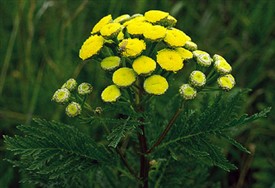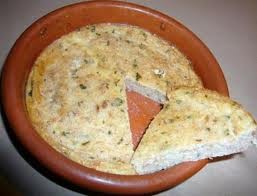Tansy pudding

Tansy

Tansy pudding
Traditional Easter food
By R B Parish
“On Easter Sunday be the pudding seen, To which the Tansy lends its sober”
Remembered in this rhyme locally, the Tansy Pudding was eaten at Easter in Nottinghamshire, a document coded as DD/E/222/67 at Nottinghamshire Archives from c.1800 has it amongst its recipes. However, recipes for the food appear in 16th century cook books. One of the earliest is recorded in 'The Accomplisht Cook' by Robert May, 1660:
“To make a Tansie the best way. Take twenty eggs, and take away five whites, strain them with a quart of good thick sweet cream, and put to it grated nutmeg, a race of ginger grated, as much cinamon beaten fine, and a penny white loaf grated also, mix them all together with a little salt, then stamp some green wheat with some tansie herbs, strain it into the cream and eggs, and stir all together; then take a clean frying-pan, and a quarter of a pound of butter, melt it, and put in the tansie, and stir it continually over the fire with a slice, ladle, or saucer, chop it, and break it as it thickens, and being well incorporated put it out of the pan into a dish, and chop it very fine; then make the frying pan very clean, and put in some more butter, melt it, and fry it whole or in spoonfuls; being finely fried on both sides, dish it up, and sprinkle it with rose-vinegar, grape-verjuyce, elder-vinegar, couslip-vinegar, or the juyce of three or four oranges, and strew on good store of fine sugar. ”
Today Tansy is a difficult plant. As a garden plant it can be invasive and in especially in Summer cause severe boils or welts to appear on the skin, and is also said to be linked to problems in pregnancy if eaten in too large an amount.
The author is researching customs and folklore on Nottinghamshire any correspondence welcome rossparish@hotmail.com